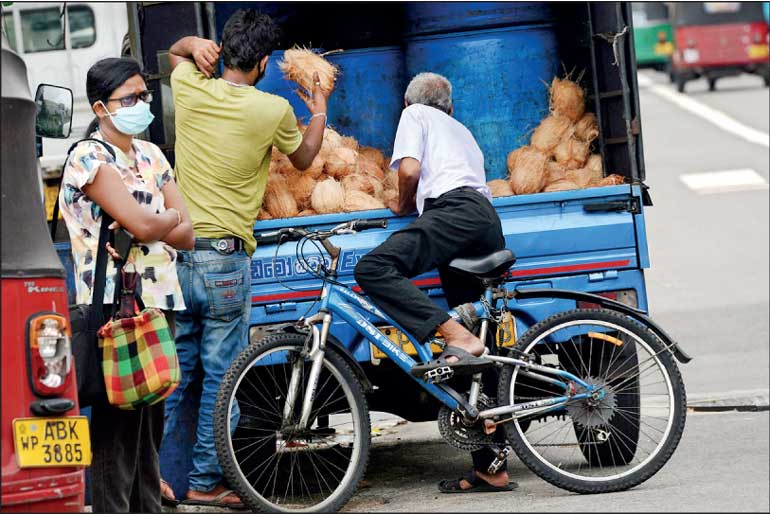Sunday Dec 07, 2025
Sunday Dec 07, 2025
Saturday, 1 January 2022 01:47 - - {{hitsCtrl.values.hits}}

Sri Lanka enters a new year with a black cloud of uncertainty hanging over its economy – Pic by Shehan Gunasekara
By Dushni Weerakoon
www.eurasiareview.com: Sri Lanka ends 2021 with foreign currency reserves in hand ($ 1.6 billion) to support a month of imports. For much of the year, a shortage of dollars saw uncleared essential imports piling up at the Colombo port as domestic prices soared. Directions from the country’s central bank to maintain an artificially fixed rate have seen a parallel black market emerge, as businesses have struggled to find hard currency.
Added to this, mandated conversion of foreign currency earnings into Sri Lankan rupees is instilling fear that the country is heading swiftly towards both a currency and economic crisis.
The last time that reserves fell to such a perilous state was in February 2009 amid the global financial crisis, as Sri Lanka battled the final stages of a separatist war. Then too, there was a stubborn disinclination to approach the International Monetary Fund (IMF) and instead lobby friendly governments for help.
With the very same political leaders and policy advisors at the helm, Sri Lanka has spent much of this year in government-to-government negotiations. The similarities end there. Unlike in 2009, the country is staring down the barrel of foreign debt settlements to the tune of $ 4.5 billion on average per annum in the foreseeable future. That harsh reality surely calls for a rethink and reset of economic strategising this time around.
The reluctance to sign on to an IMF agreement is perhaps understandable. The ‘conditions’ tied to a rescue package typically call for austerity that can have destabilising socio-political effects. While there might be a softening of conditions in a COVID-19 ravaged global economy, helping Sri Lanka to regain its creditworthiness — from its current non-investment grade — will involve some bitter medicine. For governments opposed to making themselves accountable to the IMF and surrendering policy autonomy, the alternative is to put forward credible policy measures to achieve similar end goals.
Sri Lanka has failed to do this so far. In setting the 2022 Budget, the Treasury missed an opportunity to look beyond one-off tax measures to finance fiscal gaps. Similarly, a central bank road map spelt out intended actions to bridge the immediate foreign currency gaps. Both policy documents lacked the necessary details to allay concerns about Sri Lanka’s solvency weaknesses. The Government is still hedging its bets that government-to-government deals — involving swaps, credit lines, equity sales and foreign direct investment (FDI) — will come in time to avert a major crisis.
Sri Lanka approached its regional powerhouses — China and India — for swaps and other credit lines early on. In what appears to be a reciprocal gesture, laws to ease rules and regulations governing FDI for the China-backed Colombo Port City were fast-tracked. India’s Adani Group was given a 51% stake to develop Colombo port’s west container terminal. Several overtures were made to Middle Eastern countries, especially for oil import credit lines. A $ 3.6 billion deal with Oman is on hold though, following a request for an offshore block in the Mannar Basin for oil exploration in lieu of interest payments. In this mixed bag is yet another controversial agreement to transfer a 40% government equity stake in a natural gas power plant to a US-backed firm. The latter deal has even pitted the ruling coalition partners against each other.
All told, drumming up alternative financing arrangements has not been without diplomatic headaches for the Government. A consignment of Chinese fertiliser imports that were deemed to have not met acceptable standards provoked a sharp rebuke from its embassy in Colombo.
In the meantime, India has expressed concerns over what it sees as China’s growing footprint in northern Sri Lanka power projects, a region that has traditionally been a beneficiary of Indian assistance. Still, following a visit by Sri Lanka’s Finance Minister in December, India agreed to work out an economic relief package to be announced in January 2022. There too though, protracted negotiations on yet another controversial Indian investment developing oil tanks in eastern Sri Lanka are high on the agenda.
The upshot is that Sri Lanka is negotiating for economic assistance from a weak position. Until the parties are satisfied, delays to announced credit pipelines have become routine. This uncertainty is taking a heavy toll on business confidence and the economy in general, and by association, on the Government’s credibility. Whatever scope was available at the beginning of the year to spell out and implement a convincing policy path has all but dissipated. The result is that Sri Lanka enters a new year with a black cloud of uncertainty hanging over its economy.
The longer the delay on decisive policy action to restore Sri Lanka’s sovereign creditworthiness and debt serviceability, the more painful the adjustment path will be. Even if the Government is successful in securing some short-term funds to meet its immediate foreign debt settlements, alongside a quickened pace of FDI inflows, the scale of imbalances suggests that building more effective policy strategies will require near-universal sacrifice from Sri Lankans in the year to come.
(This article is published by East Asia Forum and is part of an EAF special feature series on 2021 in review and the year ahead. Source: https://www.eurasiareview.com/31122021-the-tangled-diplomacy-of-sri-lankas-currency-crisis-analysis/)
(Dushni Weerakoon is the Executive Director and Head of Macroeconomic Policy Research at the Institute of Policy Studies
of Sri Lanka.)